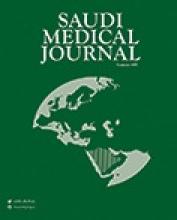To the Editor
Thank you for the article published in your journal on behalf of research carried out by ALSulaibikh et al, entitled “The accuracy of Broselow pediatric emergency tape in estimating body weight of pediatric patients”.1
It is encouraging that Saudi researchers have conducted a validation study of the Broselow tape. It is important to validate pediatric weight estimation methods locally because populations are different, and using a weight-estimation tool derived and validated elsewhere in the world might not be appropriate in another setting.2
We also welcome the authors’ recognition that the tape is less useful in older children. ALSulaibikh et al1 showed that in children over 25 kg, height correlates poorly with weight. This is consistent with our finding in a Chinese population that the tape performs badly in children over 10 years old.3
This does raise the question as to what tool should be used instead, in older and larger children. It would be good if the authors could also compare the Broselow tape with age-based formulae,2 the Mercy tape (based on mid-arm circumference and humeral length),4 or the PAWPER tape (based on height, adjusted for body habitus).5
However, if such a study were to be published it would be important to use the most appropriate statistical methods. Correlation is not the correct tool for method comparison: if a method of estimation consistently estimated weight at 50% of the correct value, the correlation would be excellent, but the agreement (or accuracy) would be extremely poor. Bland Altman analysis is the correct method because it gives a measure of trueness (the bias) and precision (the limits of agreement). An additional method is to present the proportion of estimates that lie within 10% or 20% of the true value: this gives an indication of overall accuracy. It is unfortunate that in the present study, with the focus on correlation and without details of the Bland Altman analysis, it is difficult to assess how reliable the Broselow tape really is in Saudi children.
Reply from the Author
No reply was received from the Author.
- Copyright: © Saudi Medical Journal
This is an open-access article distributed under the terms of the Creative Commons Attribution-Noncommercial-Share Alike 3.0 Unported, which permits unrestricted use, distribution, and reproduction in any medium, provided the original work is properly cited.






